Geltingia is a fungal genus in the family Helicogoniaceae. It is monotypic, containing the single lichenicolous species Geltingia associata. The genus was circumscribed in 1990 by mycologists Vagn Alstrup and David Leslie Hawksworth. The genus name honours Danish scientist Paul Gelting.

Unguiculariopsis is a genus of lichenicolous fungi in the family Cordieritidaceae. It has 29 species.
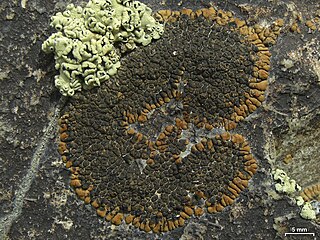
Sphaerellothecium is a genus of fungi in the family Phyllachoraceae. All of the species in the genus are lichenicolous, meaning they grow parasitically on lichens.
Merismatium is a genus of lichenicolous (lichen-dwelling) fungi of uncertain familial placement in the order Verrucariales. The genus was circumscribed in 1898 by Friedrich Wilhelm Zopf.
Endococcus is a genus of lichenicolous (lichen-dwelling) in the family Lichenotheliaceae. It has 44 species. The genus was circumscribed by the Finnish botanist William Nylander in 1855. Although at least one source places the genus in the Verrucariaceae, a 2016 study of the type species, Endococcus rugulosus, determined that it should instead be placed in the family Lichenotheliaceae of the order Dothideales; this classification echoes a placement proposed in 1979 by David Hawksworth.

Carbonea is a genus of fungi in the family Lecanoraceae. Most of the species grow on lichens. The genus is widespread, and contains 20 species. Carbonea was originally circumscribed as a subgenus of Lecidea in 1967 before it was promoted to generic status in 1983.
Rhymbocarpus is a genus of lichenicolous (lichen-dwelling) fungi in the family Cordieritidaceae. It has 10 species. The genus was circumscribed by German mycologist Friedrich Wilhelm Zopf in 1896, with Rhymbocarpus punctiformis assigned as the type species.
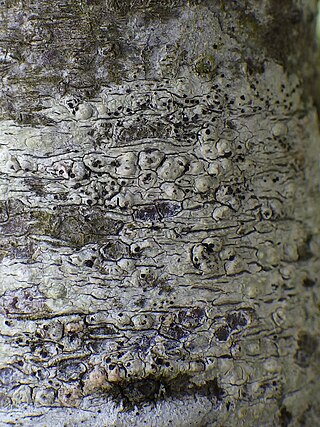
Skyttea is a genus of lichenicolous (lichen-dwelling) fungi in the family Cordieritidaceae. The genus was circumscribed in 1981 by lichenologists Martha Allen Sherwood, David L. Hawksworth, and Brian J. Coppins, with Skyttea nitschkei assigned as the type species.

Nesolechia is a genus of parasitic fungi in the family Parmeliaceae. All three species in the genus grow on lichens. Nesolechia probably evolved from a lichen ancestor, as it is closely related to many lichenized species of fungi.

Phacopsis is a genus of lichenicolous (lichen-dwelling) fungi. They are parasites of members of the large lichen family Parmeliaceae, of which they are also a member. Originally proposed by Edmond Tulasne in 1852 to contain 3 species, Phacopsis now contains 10 species, although historically, 33 taxa have been described in the genus. Many of the species are poorly known, some of them having been documented only from the type specimen.
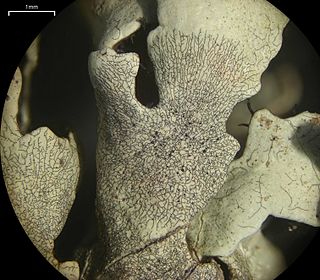
Lichenostigma is a genus of fungi in the family Phaeococcomycetaceae. It includes several species which are lichenicolous. The genus was circumscribed in 1983 by the Austrian mycologist Josef Hafellner, with Lichenostigma maureri assigned as the type species.

Lecanora impudens is a species of crustose lichen in the family Lecanoraceae. It was described as new to science by Gunnar Degelius in 1944.

Lecanora polytropa, the granite-speck rim lichen, is a species of saxicolous (rock-dwelling), crustose lichen in the family Lecanoraceae. A small, inconspicuous species that grows in the cracks of rock surfaces, it has a cosmopolitan distribution and has been recorded on all continents, including Antarctica.

Carbonea vitellaria is a species of lichenicolous fungus belonging to the family Lecanoraceae. It has a worldwide distribution. In Iceland it has been reported growing on Candelariella vitellina near Egilsstaðir and on King George Island, Antarctica.
Lichenosticta is a genus of fungi of uncertain familial placement in the order Lecanorales. It has five species. All species are lichenicolous, meaning they are parasitic on lichens.

Muellerella pygmaea is a species of lichenicolous fungus in the family Verrucariaceae. It has a cosmopolitan distribution in Arctic-alpine areas and grows on the thallus and apothecia of a number of hosts.
Carbonea assentiens is a species of lichen belonging to the family Lecanoraceae. It is found in Antarctica and in the islands of the subantarctic.
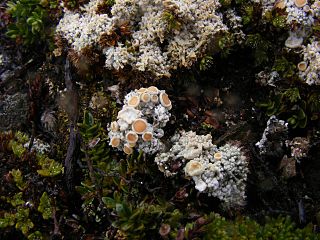
Ochrolechia frigida is a species of lichen belonging to the family Ochrolechiaceae. It was first formally described by Olof Peter Swartz in 1781, as Lichen frigidus. Bernt Arne Lynge transferred it to Ochrolechia in 1928.
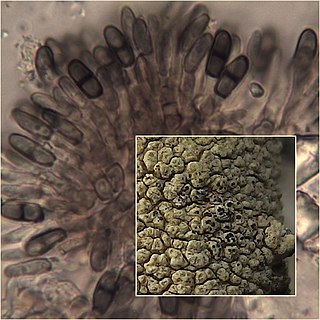
Minutoexcipula is a genus of lichenicolous (lichen-dwelling) fungi of uncertain familial placement in the order Chaetothyriales. It has eight species. The genus was circumscribed in 1994 by M. Violeta Atienza Tamarit and David Leslie Hawksworth, with Minutoexcipula tuckerae assigned as the type species. The genus is characterized both by its black convex sporodochia-like conidiomata, as well as the well-differentiated exciple on these structures.











